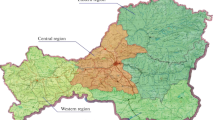Abstract
Desertification still remains an unsolved environmental problem that affects 1.5 billion people and 25% of the arid lands in the world and that represents a critical threat to the biodiversity, socioeconomic development, and sustainability of arid regions. At the local scale, desertification often results from unsustainable land management. Agricultural lands subjected to this process are intensively used for mass production of food. Despite the importance of this environmental problem, there is still no consensus concerning an accurate quantitative estimation of the desertification process in a regional scale. The lack of a clear definition and common standard methods for determination of the causes and consequences of this destructive process represents a significant obstacle to the development of appropriate strategies to control desertification. Using the method of compensatory costs and a semi-desert zone as an example, the environmental damage that occurs due to land degradation and is manifested via the loss of fertility (loss of organic and soil nutrients), has been evaluated. Such damage is determined not least because of a long-term climatic trend indicating increased aridity of the studied region. Based on the recent data, the area of agricultural lands in the south of European Russia characterized by a predominance of light chestnut soils and subjected to desertification has been determined. The regional costs for fertilizers required to compensate for the lost fertility of these natural resources have been calculated, as well as the volume of losses of their annual productivity. The resulting estimates can be used by policy makers as an important quantitative tool for determining the scale and the costs of desertification in terms of justifying the corresponding reduction of a productive potential of arid lands.

Similar content being viewed by others
REFERENCES
Bestelmeyer, B., Okin, G., Duniway, M., Archer, S., Sayre, N., Williamson, J., and Herrick, J., Desertification, land use, and the transformation of global drylands, Front. Ecol. Environ., 2015, vol. 13, no. 1, pp. 28–36.
Doklad o sostoyanii i ispol’zovanii zemel' sel’skokhozyaistvennogo naznacheniya Rossiiskoi Federatsii v 2019 godu (Report on the State and Use of Agricultural Land in the Russian Federation in 2019), Moscow: FGBNU “Rosinformagrotech”, 2021.
Dregne, H.E., Desertification of Arid Lands, The Geographical Journal, 1985, vol. 151, no. 1, p. 114.
Enters, T., Methods for the Economic Assessment of the On-and-Off-Site Impact of Soil Erosion, Bangkok: International Board for Soil Research and Management (IBSRAM), 1998.
Geist, H. and Lambin, E., Dynamic causal patterns of desertification, BioScience, 2004, vol. 54, no. 9, pp. 817–829.
Gosudarstvennyi doklad “O sostoyanii i ob okhrane okruzhayushchei sredy Rossiiskoi Federatsii v 2020 godu” (State Report “On the State and Protection of the Environment of the Russian Federation in 2020"), Moscow: Minprirody Rossii; Mos. Gos. Univ., 2021.
Imeson, A., Desertification, Land Degradation and Sustainability, UK, Chichester: John Wiley & Sons, 2011.
Korneeva, E.A., Forest melioration is as a factor of sustainable development of agroproduction in Volgograd Oblast, APK: Ekonomika, Upravlenie, 2019, no. 6, pp. 55–63.
Korneeva, E.A., Economic evaluation of ecological restoration of degraded lands through protective afforestation in the south of the Russian Plain, Forests, 2021, vol. 12, no. 10, p. 1317.
Kulik, K.N., Pavlovskii, E.S., Petrov, V.I., Kruzhilin, I.P., Manaenkov, A.S., Gabunshchina, E.B., Kust, G.S., Savost’yanov, V.K., and Tulokhonov, A.K., Opustynivanie i kompleksnaya melioratsiya agrolandshaftov zasushlivoi zony (Desertification and Integrated Reclamation of Agrolandscapes in the Arid Zone), Volgograd: VNIALMI, 2007.
Manaenkov, A.S., Lesomelioratsiya aren zasushlivoi zony (Forest Reclamation of Arid Zone Arenas), Volgograd: FNTs Agroekologii Ross. Akad. Nauk, 2018, 2nd ed.
Mantel, S., Schulp, C.J.E., and van den Berg, M., Modelling of soil degradation and its impact on ecosystem services globally. Part 1: A study on the adequacy of models to quantify soil water erosion for use within the IMAGE modeling framework, The Netherlands, Wageningen: World Soil Information, 2014.
Natsional’nyi doklad “Global’nyi klimat i pochvennyi pokrov Rossii: opustynivanie i degradatsiya zemel', institutsional’nye, infrastrukturnye, tekhnologicheskie mery adaptatsii (sel’skoe i lesnoe khozyaistvo)" (National Report "Global Climate and Soil Cover in Russia: Desertification and Land Degradation, Institutional, Infrastructural, Technological Adaptation Measures (Agriculture and Forestry)) Edel’geriev, Kh., Ed., Moscow: OOO “Izd. MBA”, 2019, vol. 2.
Reining, P., Handbook on Desertification Indicators, USA. Washington, D.C., 1978.
Salvia, R., Egidi, G., Vinci, S., and Salvati, L., 2019. desertification risk and rural development in southern europe: permanent assessment and implications for sustainable land management and mitigation policies, Land, vol. 8, no. 12, p. 191.
Shashko, D.I., Agroklimaticheskie resursy SSSR (Agro-Climatic Resources of the USSR), Leningrad: Gidrometeoizdat, 1985.
Tsvetnov, E.V., Makarov, O.A., Tsvetnova, O.B., and Kryuchkov, N.R., Experience of combined assessment of the neutral balance of land degradation in Volgograd Oblast and environmental and economic damage inflicted to this land, Dostizh. Nauki Tekh. APK, 2021, vol. 35, no. 1, pp. 12–15.
UNCCD. Desertification: A Visual Synthesis, Bonn: The United Nations Convention to Combat Desertification, 2011.
Unified State Register of Soil Resources of Russia of the V.V. Dokuchaev Soil Institute. http://egrpr.esoil.ru/content/adm/adm30.html. Cited April 16, 2022.
Weather and climate, 2022. http://www.pogodaiklimat.ru/. Cited April 20, 2022.
Zvolinskii, V.P. and Tumanyan, A.F., Desertification: main factors and causes of development, in Prirodopol’zovanie v agrarnykh regionakh Rossii (Nature Management in the Agrarian Regions of Russia), Moscow: “Sovremennye Tetradi”, 2006, pp. 67–73.
Funding
The study was carried out within the framework of the State Assignment of the Federal Research Center of Agroecology, Integrated Land Reclamation, and Protective Afforestation (theme no. FNFE-2022-0015 “Management of desertification processes in arid territories using data of the soil, climate, and land monitoring and mathematical simulation methods”).
Author information
Authors and Affiliations
Corresponding author
Ethics declarations
Conflict of Interest. The authors declare that they have no conflict of interest.
Statement of the Welfare of Animals. This article does not contain any studies with animals performed by any of the authors.
Additional information
Translated by N. Statsyuk
Rights and permissions
About this article
Cite this article
Korneeva, E.A. Evaluation of Environmental Damage Associated with Desertification of Arid Territories on the South of European Russia. Arid Ecosyst 13, 59–64 (2023). https://doi.org/10.1134/S2079096123010043
Received:
Revised:
Accepted:
Published:
Issue Date:
DOI: https://doi.org/10.1134/S2079096123010043




